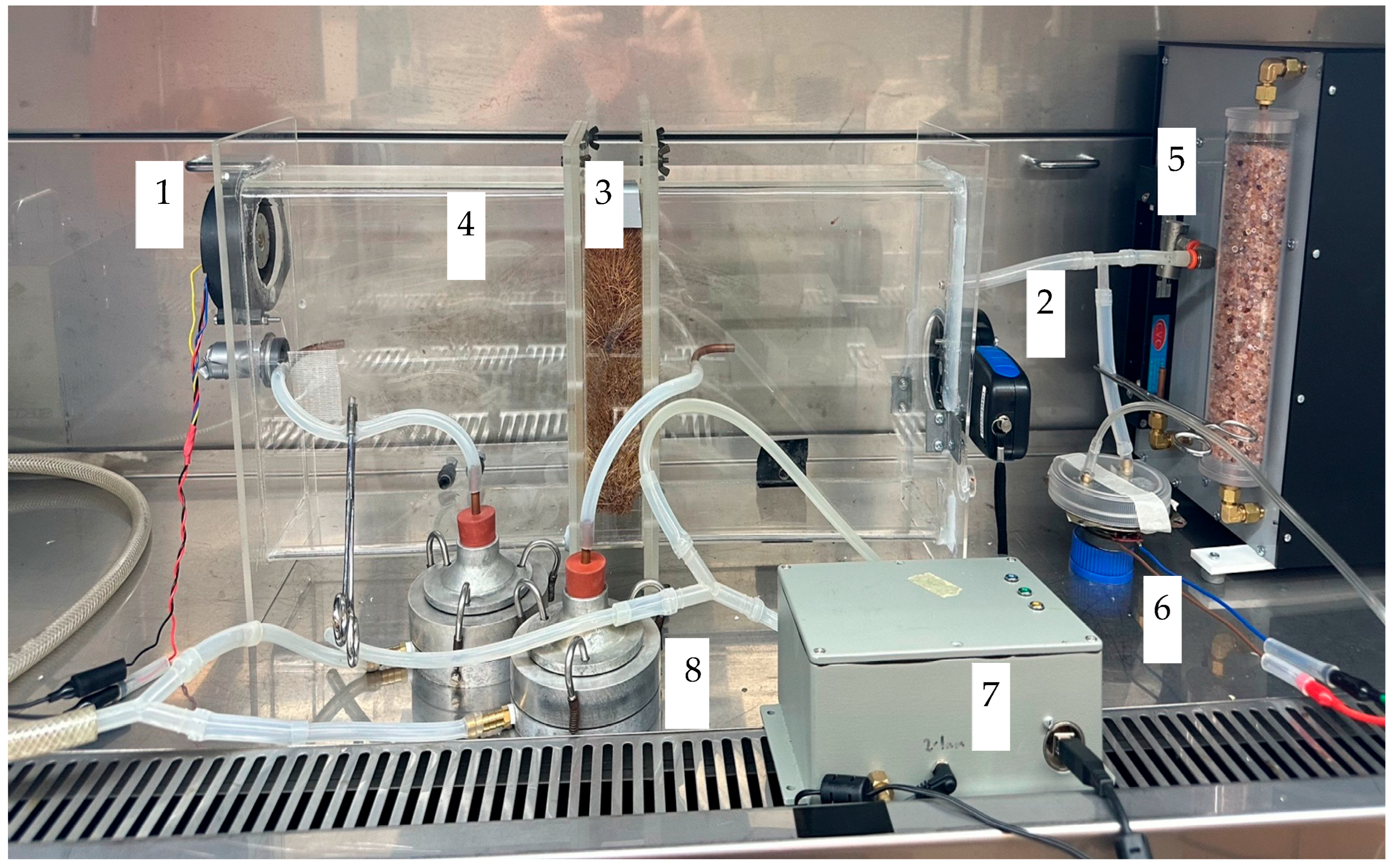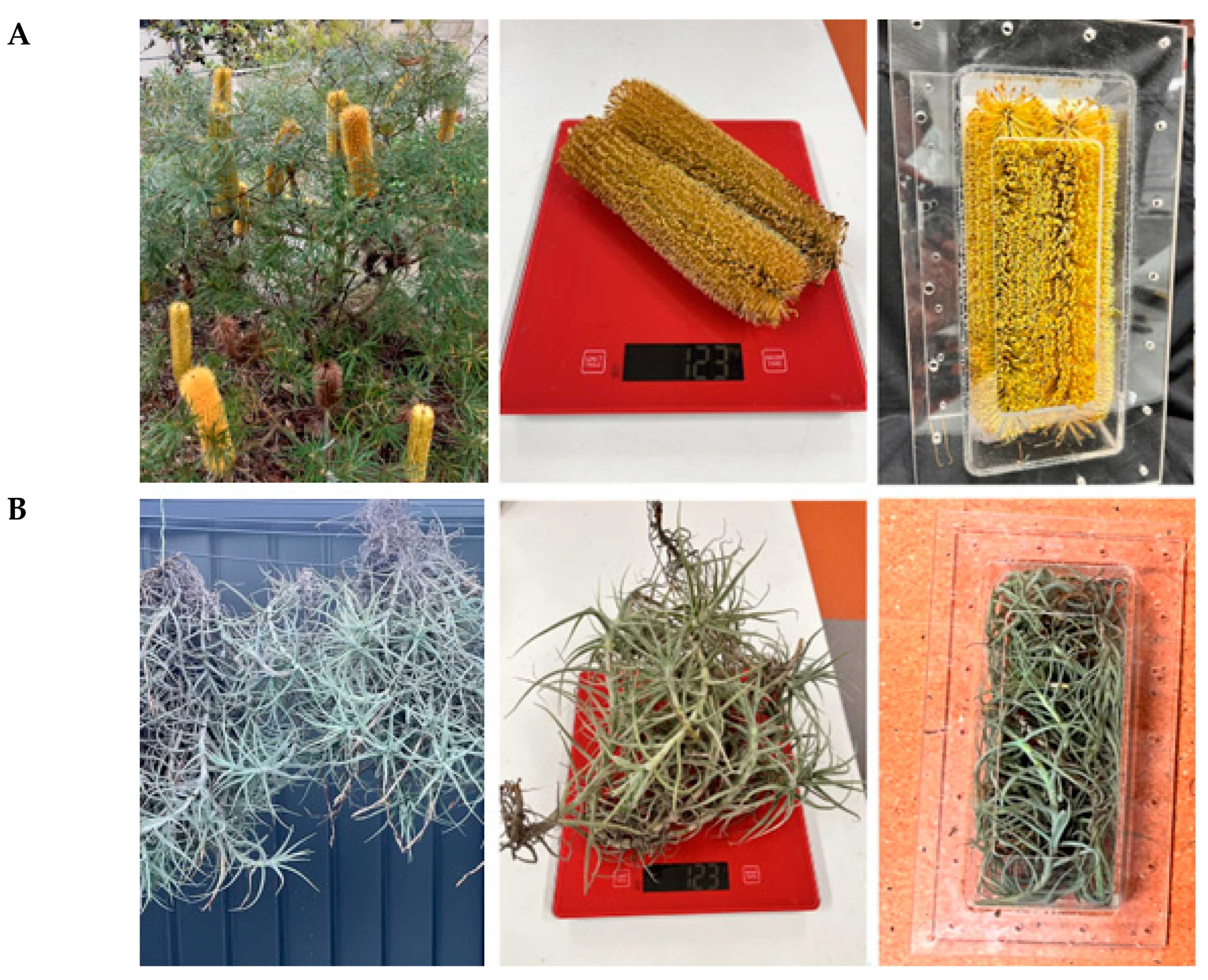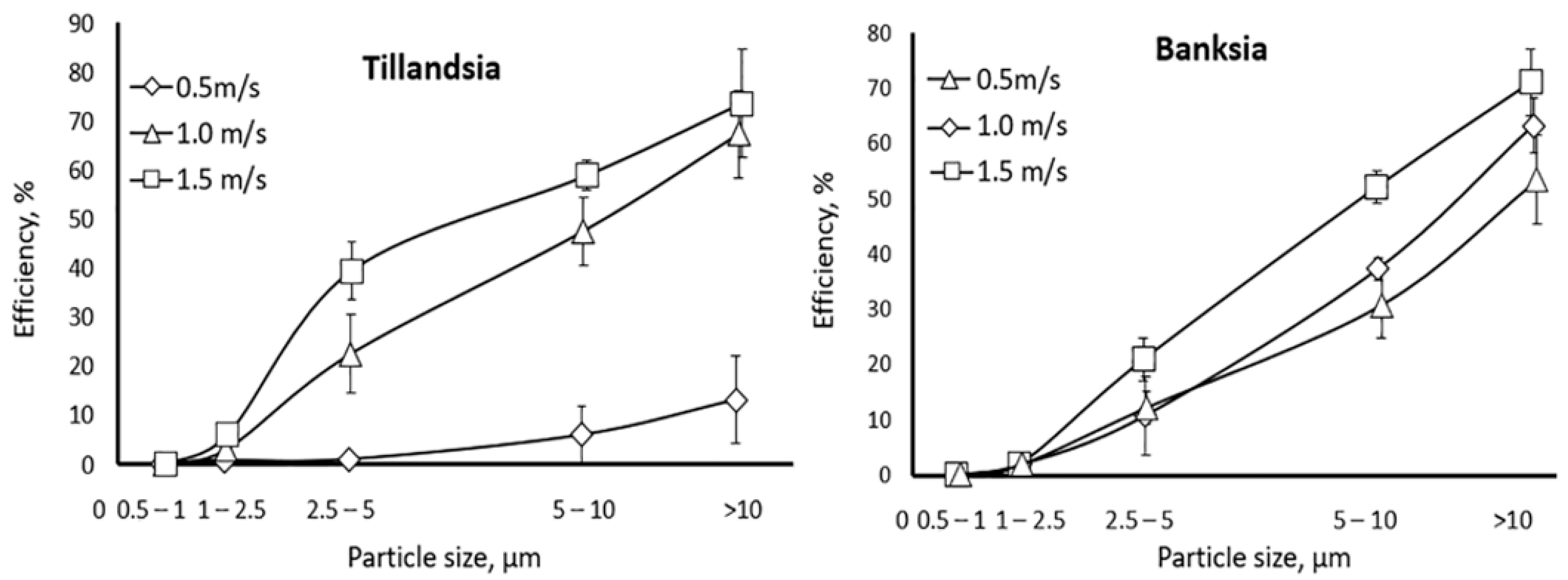Filtration of Mineral and Biological Aerosols by Natural Plant Panels
Abstract
1. Introduction
2. Materials and Methods
2.1. Laboratory Setup and Experiment Methodology
2.2. Plant Selection
2.3. Particle Selection and Generation/Cultivation
3. Results and Discussion
4. Conclusions
Author Contributions
Funding
Institutional Review Board Statement
Informed Consent Statement
Data Availability Statement
Acknowledgments
Conflicts of Interest
References
- Chell, S.; Tomson, N.; Kim, T.D.H.; Michael, R.N. Performance of native succulents, forbs, and grasses on an extensive green roof over four years in subtropical Australia. Urban For. Urban Green. 2022, 74, 127631. [Google Scholar] [CrossRef]
- Kim, T.D.H.; Yu, B.; Srichandra, J.; Low-Choy, S.; Michael, R.N. Water flux and biomass production of native plants at different substrate compactions for landfill phytocaps in Southeast Queensland, Australia. Ecol. Eng. 2022, 183, 106745. [Google Scholar] [CrossRef]
- Nakamura, F. (Ed.) Green Infrastructure and Climate Change Adaptation: Function, Implementation and Governance; Springer Nature: Singapore, 2022. [Google Scholar] [CrossRef]
- Al-Shaarani, A.A.Q.A.; Pecoraro, L. A review of pathogenic airborne fungi and bacteria: Unveiling occurrence, sources, and profound human health implication. Front. Microbiol. 2024, 15, 1428415. [Google Scholar] [CrossRef]
- Zhao, J.; Jin, L.; Wu, D.; Xie, J.; Li, J.; Fu, X.; Cong, Z.; Fu, P.; Zhang, Y.; Luo, X.; et al. Global airborne bacterial community—Interactions with Earth’s microbiomes and anthropogenic activities. Proc. Natl. Acad. Sci. USA 2022, 119, e2204465119. [Google Scholar] [CrossRef] [PubMed]
- Duan, X.; Gu, H.; Lam, S.S.; Sonne, C.; Lu, W.; Li, H.; Chen, X.; Peng, W. Recent progress on phytoremediation of urban air pollution. Chemosphere 2024, 349, 140821. [Google Scholar] [CrossRef]
- Paull, N.J.; Irga, P.J.; Torpy, F.R. Active botanical biofiltration of air pollutants using Australian native plants. Air Qual. Atmos. Health 2019, 12, 1427–1439. [Google Scholar] [CrossRef]
- Paull, N.J.; Krix, D.; Irga, P.J.; Torpy, F.R. Airborne particulate matter accumulation on common green wall plants. Int. J. Phytoremediation 2020, 22, 594–606. [Google Scholar] [CrossRef]
- Peng, Z.; Deng, W.; Hong, Y.; Chen, Y. An experimental work to investigate the capabilities of plants to remove particulate matters in an enclosed greenhouse. Air Qual. Atmos. Health 2020, 13, 477–488. [Google Scholar] [CrossRef]
- Tomson, N.; Michael, R.N.; Agranovski, I.E. Removal of particulate air pollutants by Australian vegetation potentially used for green barriers. Atmos. Pollut. Res. 2021, 12, 101070. [Google Scholar] [CrossRef]
- Tomson, N.; Michael, R.N.; Agranovski, I.E. Classic Theory of Aerosol Filtration for Application to Urban Green Infrastructure. Water Air Soil Pollut. 2025, 236, 188. [Google Scholar] [CrossRef]
- Gong, Y.; Zhou, T.; Wang, P.; Lin, Y.; Zheng, R.; Zhao, Y.; Xu, B. Fundamentals of Ornamental Plants in Removing Benzene in Indoor Air. Atmosphere 2019, 10, 221. [Google Scholar] [CrossRef]
- Kim, K.J.; Kil, M.J.; Song, J.S.; Yoo, E.H.; Son, K.-C.; Kays, S.J. Efficiency of Volatile Formaldehyde Removal by Indoor Plants: Contribution of Aerial Plant Parts versus the Root Zone. J. Am. Soc. Hortic. Sci. 2008, 133, 521–526. [Google Scholar] [CrossRef]
- Kim, H.-H.; Yang, J.-Y.; Lee, J.-Y.; Park, J.-W.; Kim, K.-J.; Lim, B.-S.; Lee, G.-W.; Lee, S.-E.; Shin, D.-C.; Lim, Y.-W. House-plant placement for indoor air purification and health benefits on asthmatics. Environ. Health Toxicol. 2014, 29, e2014014. [Google Scholar] [CrossRef]
- Li, J.; Chen, S.; Zhong, J.; Lin, S.; Pang, S.; Tu, Q.; Agranovski, I.E. Removal of formaldehyde from indoor air by potted Sansevieria trifasciata plants: Dynamic influence of physiological traits on the process. Environ. Sci. Pollut. Res. 2024, 31, 62983–62996. [Google Scholar] [CrossRef]
- Pettit, T.; Irga, P.J.; Torpy, F.R. The in situ pilot-scale phytoremediation of airborne VOCs and particulate matter with an active green wall. Air Qual. Atmos. Health 2019, 12, 33–44. [Google Scholar] [CrossRef]
- El-Tanbouly, R.; Hassan, Z.; El-Messeiry, S. The Role of Indoor Plants in air Purification and Human Health in the Context of COVID-19 Pandemic: A Proposal for a Novel Line of Inquiry. Front. Mol. Biosci. 2021, 8, 709395. [Google Scholar] [CrossRef]
- Zhang, J.; Netzel, M.E.; Pengelly, A.; Sivakumar, D.; Sultanbawa, Y. A Review of Phytochemicals and Bioactive Properties in the Proteaceae Family: A Promising Source of Functional Food. Antioxidants 2023, 12, 1952. [Google Scholar] [CrossRef] [PubMed]
- Godman, L. East Melbourne Wall Garden; Lloyd Godman: Studio LAB Xeric. Available online: https://www.lloydgodman.net/suspend/Melbourne1.html (accessed on 31 March 2025).
- Radić, M.; Brković Dodig, M.; Auer, T. Green Facades and Living Walls—A Review Establishing the Classification of Construction Types and Mapping the Benefits. Sustainability 2019, 11, 4579. [Google Scholar] [CrossRef]
- Kandelan, S.N.; Yeganeh, M.; Peyman, S.; Panchabikesan, K.; Eicker, U. Environmental study on greenery planning scenarios to improve the air quality in urban canyons. Sustain. Cities Soc. 2022, 83, 103993. [Google Scholar] [CrossRef]
- Pugh, T.A.; Mackenzie, A.R.; Whyatt, J.D.; Hewitt, C.N. Effectiveness of green infrastructure for improvement of air quality in urban street canyons. Env. Sci. Technol. 2012, 46, 7692–7699. [Google Scholar] [CrossRef]
- Oquendo-Di Cosola, V.; Olivieri, F.; Ruiz-García, L. A systematic review of the impact of green walls on urban comfort: Temperature reduction and noise attenuation. Renew. Sustain. Energy Rev. 2022, 162, 112463. [Google Scholar] [CrossRef]
- Agranovski, I.E.; Usachev, E.V. In-situ rapid bioaerosol detection in the ambient air by miniature multiplex PCR utilizing technique. Atmos. Environ. 2021, 246, 118147. [Google Scholar] [CrossRef]
- Santamouris, M.; Georgakis, C.; Niachou, A. On the estimation of wind speed in urban canyons for ventilation purposes—Part 2: Using of data driven techniques to calculate the more probable wind speed in urban canyons for low ambient wind speeds. Build. Environ. 2008, 43, 1411–1418. [Google Scholar] [CrossRef]
- Hinds, W.C. Aerosol Technology: Properties, Behavior, and Measurement of Airborne Particles, 2nd ed.; John Wiley & Sons, Inc.: New York, NY, USA, 1999. [Google Scholar]
- Kim, H.B.; Lee, W.J.; Choi, S.C.; Lee, K.B.; Lee, M.-H. Filter quality factors of fibrous filters with different fiber diameter. Aerosol Sci. Technol. 2021, 55, 154–166. [Google Scholar] [CrossRef]
- ANPSA. Banksia spinulosa. Australian Native Plants Society (Australia). 2025. Available online: https://anpsa.org.au/plant_profiles/banksia-spinulosa/ (accessed on 20 May 2025).
- Griffith Archive. Candlestick Banksia (Banksia spinulosa). Toohey Forest Flora Collection. 2002. Available online: https://griffitharchive.griffith.edu.au/nodes/view/859 (accessed on 20 May 2025).
- Milla Rose. The Banksia: Everything You Need to Know. 2022. Available online: https://millarose.com.au/blogs/flowers/banksia-the-ultimate-guide (accessed on 20 May 2025).
- ANBG. Information About Australia’s Flora: Growing Native Plants: Banksia spinulosa; Australian National Botanic Gardens and Centre for Australian National Biodiversity Research: Canberra, Australia, 2015. Available online: https://www.anbg.gov.au/gnp/gnp7/banksia-spinulosa.html (accessed on 18 May 2025).
- Cornell Cooperative Extension. Air Plants (Tillandsia). Warren County Master Gardener Articles. 2021. Available online: http://warren.cce.cornell.edu/gardening-landscape/warren-county-master-gardener-articles/air-plants-tillandsia (accessed on 20 May 2025).
- Godman, L. Plants & Architecture: Critical Comparisons of Xeric and Hydric Plant Systems, 1st ed.; Photo-Synthesis Media; 2023; Available online: https://www.lloydgodman.net/Publications/Plants_and_architecture.html (accessed on 20 May 2025).
- Beck, A.; Duax, S. How to Grow Air Plants That Don’t Need Soil to Survive; Better Homes & Gardens: Des Moines, IA, USA, 2025; Available online: https://www.bhg.com/gardening/houseplants/care/grow-air-plants (accessed on 20 May 2025).
- Godman, L.; Jones, S.; Harris, G. A “Flight” Manual for Air Plants. CTBUH J. 2015. Available online: https://www.lloydgodman.net/Cv/Press/TBUH1.pdf (accessed on 20 May 2025).
- Sengo, Z. Air Plants: The Curious World of Tillandsias; Timber Press, Inc.: Portland, OR, USA, 2014. [Google Scholar]
- ASA. Bruce Dunstan. Aroid Society of Australia. Available online: https://www.aroids.net/bruce-dunstan (accessed on 30 March 2025).
- ARB. Inhalable Particulate Matter and Health (PM2.5 and PM10)|California Air Resources Board. 2025. Available online: https://ww2.arb.ca.gov/resources/inhalable-particulate-matter-and-health?keywords=2025 (accessed on 20 May 2025).
- WHO. WHO Global Air Quality Guidelines: Particulate Matter (PM2. 5 and PM10), Ozone, Nitrogen Dioxide, Sulfur Dioxide and Carbon Monoxide, 1st ed.; World Health Organization: Geneva, Switzerland, 2021.
- Taussig, L.M.; Landau, L.; Le Souef, P.; Martinez, F.D.; Morgan, W.J.; Sly, P. Pediatric Respiratory Medicine, 2nd ed.; Mosby International: London, UK, 2008. [Google Scholar]
- Health Canada. Aspergillus Niger Group—Information Sheet. In Pollinosis; Falagiani, P., Ed.; CRC Press: Boca Raton, FL, USA, 1989. Available online: https://www.canada.ca/en/health-canada/services/chemical-substances/fact-sheets/chemicals-glance/aspergillus-awamori-aspergillus-brasiliensis.html (accessed on 13 June 2014).
- Scheermeyer, E.; Agranovski, I.E. Design and evaluation of a new device for fungal spore aerosolization for laboratory applications. J. Aerosol Sci. 2009, 40, 879–889. [Google Scholar] [CrossRef]
- Li, X.; Zhang, T.; Wang, J.; Wang, S. Prediction of Aerosolized Fungal Spores by Determining Respiratory Intensity of the Growing Colony. Aerosol Air Qual. Res. 2020, 20, 776–786. [Google Scholar] [CrossRef]
- Tomson, M.; Kumar, P.; Barwise, Y.; Perez, P.; Forehead, H.; French, K.; Morawska, L.; Watts, J.F. Green infrastructure for air quality improvement in street canyons. Env. Int. 2021, 146, 106288. [Google Scholar] [CrossRef]
- Falagiani, P. Pollinosis; CRC Press: Boca Raton, FL, USA, 1989. [Google Scholar]
- Knox, R.B. Pollen and Allergy; Edward Arnold: London, UK, 1979. [Google Scholar]
- Li, H.; Wu, Z.-F.; Yang, X.-R.; An, X.-L.; Ren, Y.; Su, J.-Q. Urban greenness and plant species are key factors in shaping air microbiomes and reducing airborne pathogens. Environ. Int. 2021, 153, 106539. [Google Scholar] [CrossRef]





Disclaimer/Publisher’s Note: The statements, opinions and data contained in all publications are solely those of the individual author(s) and contributor(s) and not of MDPI and/or the editor(s). MDPI and/or the editor(s) disclaim responsibility for any injury to people or property resulting from any ideas, methods, instructions or products referred to in the content. |
© 2025 by the authors. Licensee MDPI, Basel, Switzerland. This article is an open access article distributed under the terms and conditions of the Creative Commons Attribution (CC BY) license (https://creativecommons.org/licenses/by/4.0/).
Share and Cite
Tomson, N.; Michael, R.N.; Agranovski, I.E. Filtration of Mineral and Biological Aerosols by Natural Plant Panels. Atmosphere 2025, 16, 694. https://doi.org/10.3390/atmos16060694
Tomson N, Michael RN, Agranovski IE. Filtration of Mineral and Biological Aerosols by Natural Plant Panels. Atmosphere. 2025; 16(6):694. https://doi.org/10.3390/atmos16060694
Chicago/Turabian StyleTomson, Nathalie, Ruby Naomi Michael, and Igor E. Agranovski. 2025. "Filtration of Mineral and Biological Aerosols by Natural Plant Panels" Atmosphere 16, no. 6: 694. https://doi.org/10.3390/atmos16060694
APA StyleTomson, N., Michael, R. N., & Agranovski, I. E. (2025). Filtration of Mineral and Biological Aerosols by Natural Plant Panels. Atmosphere, 16(6), 694. https://doi.org/10.3390/atmos16060694









